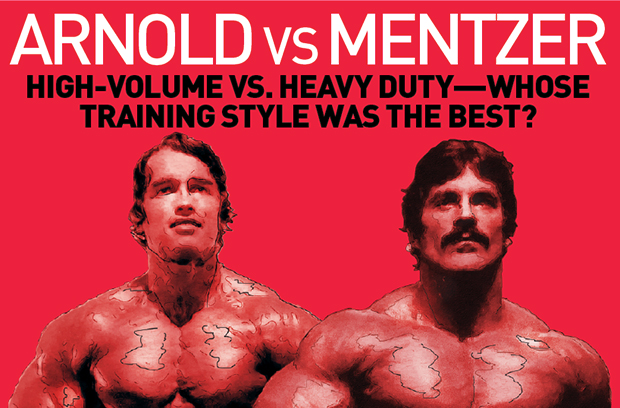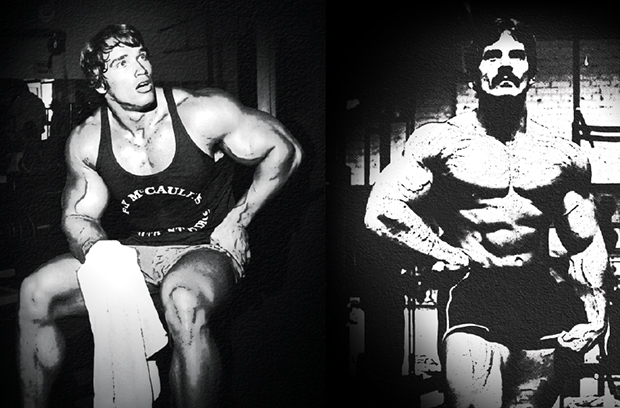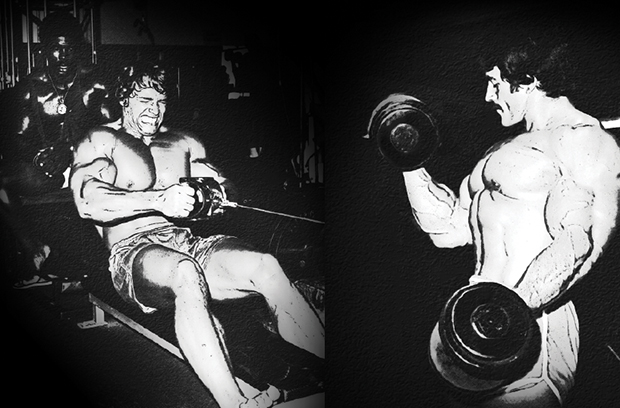ARNOLD VS. MENTZER

HIGH VOLUME VERSUS HEAVY DUTY—WHOSE TRAINING STYLE WAS THE BEST?
In this article, we’ll take a look at high-volume training (Arnold-style) versus Heavy Duty training (Mike Mentzer style). I’ll go over the pros and cons of each, and the theories behind both. Then, I’ll break down which one works best.
If your goal is to build muscle and get stronger, something you will learn very early on is to not reinvent the wheel. A lot of people who are new to lifting and training start to seek out training info and programs to help them progress and improve their training. This is a good thing when you’re just starting out. Once you start lifting seriously and get to the stage where you’re researching programming and training methodologies, you may discover two icons in the sport of bodybuilding: Mike Mentzer and Arnold Schwarzenegger.
While both of these men lifted weights as a means to build muscle and get stronger, their views on how to lift weights for maximum results varied greatly.
After many years competing, coaching, and training, I have a great understanding of both these iconic men and their place in the sport of bodybuilding. In my own training and coaching others, I have used both the Arnold methodology (strength plus volume) and the Menzter approach (HIT) in training. In this article, I plan to share with you some history of these iconic men, their training philosophies, and how this could benefit you and your training.
Before we get into the training methodologies, let’s first review some old-school bodybuilding history.
In late 1979, Mike Mentzer won the heavyweight class of the Mr. Olympia, with a perfect 300 score, but he lost in the overall to Frank Zane, who was awarded the title for a third time in a row. In the 1980 Mr. Olympia, he placed fourth (in a tie with Boyer Coe) behind Arnold Schwarzenegger, Chris Dickerson, and Frank Zane. This also happened to be one of the most controversial Mr. Olympias to date, and Mike’s placing was part of the reason. It’s been said that this contest is the reason he retired so young. But that’s a story for another feature.
Arnold’s career onstage is a very decorated one. Arnold’s bodybuilding victories include five Mr. Universe (four NABBA [England] and one IFBB [USA]) wins, and seven Mr. Olympia wins—a record that would stand until Lee Haney won his eighth consecutive Mr. Olympia title in 1991.
Both of these men had incredible careers as pro bodybuilders, but Arnold has a legacy that rivals the best of all time in bodybuilding.

The Training Methodologies:
Mike Mentzer: Heavy Duty HIT-Style Training
Mike Mentzer’s training philosophy was known as Heavy Duty training. It was based off something known as high-intensity training.
In this style of training, the goal was short but intense, challenging workouts where the you don’t necessarily want a large volume of sets and reps, but actually quite the opposite.
The goal is to push your body harder and constantly challenge it to cause adaptation. Instead of doing lots of sets and reps, you would focus more on increasing the intensity. There would be a low volume of sets but a much higher intensity. Every set would be taken to failure and beyond.
According to Mentzer’s training, there were levels for each person depending on their level of training. For example, a new lifter wouldn’t train at the same level as an experienced lifter. The more experienced you were, the more you had to challenge yourself with a variety of training tactics and methods to constantly challenge the body and make it adapt to stress.
When most people were training doing anywhere from about 8 to 20 reps in a set and doing multiple sets of that weight, Mentzer took a different approach and focused on intensity over workout volume.
Mentzer lowered the reps and worked in a 6- to 9-rep range. The goal: Choose a weight so heavy that you reach absolute failure at 6 to 9 reps, then keep going.
The HIT Heavy Duty method didn’t stop at failure of the set; this, for the most part, was only the beginning.
The Heavy Duty method also used other tactics such as forced reps, negative reps, and rest-pause and more.
A forced rep is when you can no longer complete a rep on your own and your spotter/training partner helps you through more reps with assistance.
Negative reps are where you focus only on the lowering (eccentric) portion of the rep.
Rest-pause reps are where, once you finish the set, you hit a few single reps after the set was over, resting in between each rep.
The Mentzer Heavy Duty style can be summed up as short, intense workouts taken to absolute failure and beyond. The goal was to challenge your body and constantly push its limits in terms of strength, fight fatigue, and cause stress and adaptation.
Arnold Schwarzenegger: Body Part High-Volume Training (Mixed with a Strength Base)
Arnold’s approach to strength and building muscle is more of a classic focus that is still used to this day by countless gym-goers and competitors.
This approach focuses more on quality over quantity. You focus on hitting specific muscle groups with a variety of exercises, using reps varying from about 5 to 15, then combine that with a higher volume of sets ranging from 3 to 10.
This approach was popularized in magazines and articles over the years, and somewhat became the way most people train nowadays. If you look at most programs that people do now, they’re based on this principle.

Comparing Mentzer’s Heavy Duty vs. Arnold’s High-Volume Training Approach
Mentzer’s Heavy Duty: The Good & The Bad
Mike Mentzer’s Heavy Duty type training can help you take your training to another level and push past plateaus. If you have been using the standard high volume, body part split approach in your training, you could change things up and run a Heavy Duty HIT-type program for four to eight weeks, which would cause your body to adapt to a new training stimulus.
Heavy Duty Training—The Good:
• Using HIT-type training can help you push past plateaus and vary your training.
• Training at a higher intensity will allow you to lift some seriously heavy weights, which in turn should make you stronger. Becoming stronger is clearly always good.
• Using negatives will help build muscle and strength. The eccentric portion of the rep (the negative) is very important for strength and hypertrophy.
• If you don’t have a lot of time in the gym, this type of workout is a great option. You can get an intense workout done in 30 minutes or even less. In addition, you don’t need to train frequently. You could do three full-body workouts a week and still get results with this type of training.
Something that’s very important is that this type of training shouldn’t be used all the time. It’s a great option to use a few times a year to change things up and give your body a new training stimulus, but it isn’t recommended to train at this level of intensity all the time.
Training to absolute failure has a lot of negatives that can affect your training and results.
Heavy Duty Training—The Bad:
• You have a much higher risk of injury when training to absolute failure. Most top lifters and athletes don’t train all-out all the time.
• With forced reps and negatives, there’s a much higher chance of tearing a muscle or tendon.
• You can impact your central nervous system negatively. If you’re constantly training to failure and beyond, your nervous system will get very taxed. You may find a lot of athletes that train this way are always tired and sometimes rely heavily on pre-workouts and energy supplements to help them in training and outside the gym.
• It’s very hard to do this type of training without a training partner or spotter. With heavy training, forced reps, and negatives a good training partner or spotter is essential for maximal results and, of course, safety when training.
Higher Volume Training: The Good & The Bad
The Arnold approach to training has countless benefits for building muscle, getting stronger, and reducing injuries and improving longevity in the sport.
Having a higher volume of sets and reps is a proven method for size and strength.
However, something to note is that Arnold had a background in powerlifting along with bodybuilding. Arnold built a base of strength that carried over into his bodybuilding training. The conventional bodybuilding approach of higher volume of sets and reps works, but the goal should always be to build a base of strength with the main lifts such as squats, deadlifts, and bench presses.
Arnold-Style Training—The Good:
• High frequency training works. This type of training has helped countless people build muscle and get stronger.
• Volume builds muscle. In the real world and also in countless studies, the most important factor for building muscle is volume. If you want to build muscle and get stronger, you need to have a foundation of volume. This is seen very much in the powerlifting world, where volume plays a huge role for about 75 percent of most powerlifters’ training.
• Training with higher volume of sets and reps is a bit easier on the body overall. When training at a higher level of intensity, the tendons and joints can sometimes pay the price. With training lighter with more sets and reps, this type of training is much easier on the joints. For people with years of training or older, mature lifters, this approach will be much easier on your body in many ways.
• Training partners and spotters are a bonus, but not essential. With the conventional body part split higher volume approach, you aren’t training with very heavy weights or doing forced reps or negatives. Therefore, you can get a great workout with or without a training partner. While a training partner always makes training better, for a lot of people, this isn’t an option. If you train on your own, this method is much better.
Arnold-Style Training—The Bad:
• A lot of people who do high volume and body part split training don’t focus enough on the basic compound lifts. While bicep curls and leg extensions are good exercises, there should always be a focus on development of strength based around compound movements such as squats, bench press, deadlifts, and overhead presses.
• Try to not fall into a rut. Often, people have a tendency to do the same workouts day in and day out. For example, Monday is international chest and bicep day, as everyone does chest on Monday. For results and progress, it’s important to stick to basics and basic lifting principles but try to not fall into the rut of doing the same exercises with the same weight for sets and reps all the time. Challenge yourself and be sure to keep some variety in your training.
• For some people, this type of training takes up too much time. Ideally you will need four or five days a week for about an hour minimum to hit the sets and reps of volume and variety needed to build muscle and strength. If you have a busy lifestyle, this might be difficult.
The Wrap-Up
There is no doubt that both Arnold Schwarzenegger and Mike Mentzer are icons in the bodybuilding world. Both of these men were incredible athletes, were highly intelligent, and trained insanely hard. Most people can only dream of having the level of development and strength that these two possessed.
We can learn a lot from both of these men and their training philosophies. Give both of these training methods a try and see how they work for you.

